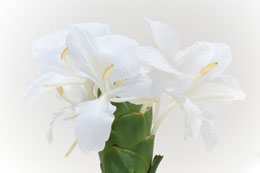Strongly scented tuberose plant grows from its bulbs. Its correct planting is essential for good flower and foliage growth. Let us learn more about this plant.

The tuberose flower's extracts are used for developing middle notes in perfumes since the Middle Ages. This plant is botanically known as
Polianthes tuberosa and is a perennial plant of the agave family
Agavaceae. It is a dominant flower used in most Indian cultures and festivals. No important religious ceremony is complete without offerings or decorations of this white scented flower. It is as important as the marigold flower when it comes to traditional rituals.
Tuberose
It grows 18 - 24 inches in height with lots of long, bright green, slender leaves clustered at the base of the plant that taper towards the top, and smaller-sized leaves that grow on the flower's stalks. The flowers grow on elongated spikes up to 18 - 20 inches in height. They produce clusters of fragrant waxy white flowers that bloom successively from the bottom towards the top of the spike. Each spike easily contains more than 50 - 60 flower buds. The flowers emit a strong scent that gets stronger during nighttime. The flowers are primarily night blooming, but bloom under the hot sun too. In Iran, oil is extracted from the flowers to create perfumes that are complex, exotic, sweet, or floral. Tuberoses are easy to grow and can be easily propagated through bulbs and a division of rhizomes or clumps.
Plantation
- Plant bulbs in late winter to early spring and summers too. They are easily available and you can even use bulbs from existing plants. Further, their seeds are also sold but they are not true tuberose seeds as flowers with sterile seeds do not set.
- They need plenty of sunshine irrespective of where they are grown; in flower beds, pots, or containers.
- Choose soil that is well draining and loamy with plenty of organic compost, peat moss, ground bark, or decomposed manure added. They grow better in drier soils than water retaining ones.
- Tuberose bulbs are generally grown in clumps, so dig a hole to the depth deep enough to hold clumps yet leave the tip of the bulbs at the soil level.
- Space each clump 8 - 12 inches part.
- Water around the clumps well and then withhold watering until the green tips emerge. But make sure that the soil does not dry out completely either. Once the tip emerges continue watering sparingly. More the foliage, more flower stalks should be expected.
- Although fertilizing is not essential, a light liquid fertilizer can be added. However, this should be done only around the plants and never close to the clumps.
- Flower stalks can appear anywhere between three to four months around mid summer to late summer or early fall.
- Slugs and snails are the only pest that can harm these plants, and excess water can set rot in the bulbs.
- If you intend to use tuberose as cut flowers, cut only ¾ of the stalk and not the leaves.
- Once the flowering season is over, remove the bulbs or leave them to multiply in the ground. Expert gardeners recommend that they flower better in the second year if left in the ground undisturbed. Divide clumps every 2 - 3 years.
- If you do want to take the tubers out, allow the plant leaves to wilt and fall to the ground naturally. Dig around and scoop out the whole clump. Dust off all the dirt, sprinkle some germicidal powder, and store in mesh bags in a dry ventilated area.
The beautiful tuberose is used traditionally in Hawaii to create Leis as its scented flowers are very tantalizing. Make sure that the bulbs are planted with care and enjoy the fragrant blooms throughout spring and summer!






 The tuberose flower's extracts are used for developing middle notes in perfumes since the Middle Ages. This plant is botanically known as Polianthes tuberosa and is a perennial plant of the agave family Agavaceae. It is a dominant flower used in most Indian cultures and festivals. No important religious ceremony is complete without offerings or decorations of this white scented flower. It is as important as the marigold flower when it comes to traditional rituals.
The tuberose flower's extracts are used for developing middle notes in perfumes since the Middle Ages. This plant is botanically known as Polianthes tuberosa and is a perennial plant of the agave family Agavaceae. It is a dominant flower used in most Indian cultures and festivals. No important religious ceremony is complete without offerings or decorations of this white scented flower. It is as important as the marigold flower when it comes to traditional rituals.